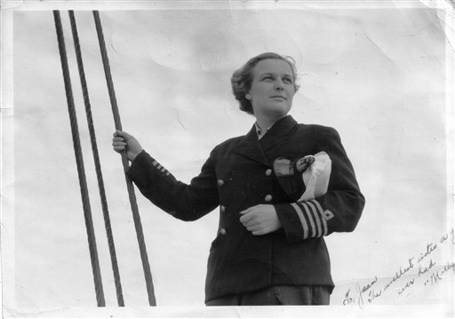Myrtle ‘Molly’ Kool (February 23, 1916 – February 25, 2009), a Canadian and North America’s First Certified Female Sea Captain.
Molly’s boat collided with another ship in the dense fog. Falling overboard, she grabbed a piece of floating timber to keep afloat. Passengers from the boat began to throw life preservers at her. Her response? “Stop throwing useless things at me, send a boat!” This is a story often told about Molly Kool to demonstrate her courage and presence of mind. Sometimes described as “frivolous and pretty” on land, she earned the respect of her crew, doing any and every job necessary from repairing engines to sewing canvas and splicing rope
Myrtle Kool, known as Molly, was the second of five children born to Myrtle Anderson and Paul Kool, at Alma, New Brunswick in 1916. Paul Kool was a Dutch sea captain who sailed his scow the Jean K between ships anchored at sea and the shore from Alma on Fundy Bay as far south as Boston. Although, his boat was named after his oldest daughter, Molly was the one who took to the sea spending as much time on board with her father as she could.
Wanting to make her career on the sea, she applied to the Merchant Marine school in St. John, New Brunswick. She was turned down, but persevered and in 1937 earned a mate’s certificate. Two years later in 1939, she earned a Coastal Master’s Certificate at the Merchant Marine Institute in Yarmouth, Nova Scotia, making her the first woman in North America to become a certified Captain. (They had to amend the Canadian Shipping Act to include the word “she.”) Molly was also only the second woman in the world to achieve this standing, the first being Anna Shchetinina of the Soviet Union just a few years earlier.
Molly’s father turned the Jean K over to her and for five years she sailed some of the roughest seas in the world. In addition to the rough tides at Fundy Bay, she navigated through drift ice, snow, fog, and gale force winds to carry her cargo, most often paper and pulp products.
In 1944, while waiting on repairs after a gas explosion, Molly married Ray Blaisdell and decided to retire from the sea. She and Blaisdell lived in Maine for the next 20 years before Blaisdell’s death, where she sold Singer sewing machines and sailed for pleasure rather than profit. At some point in the 1960s, she married John Carney.
Molly Kool died of pneumonia on February 25, 2009 at the age of 93. She lived a long life, but in 2003 when the “Molly Kool”, named in her honor, was launched she was still able to give the captain instructions on sailing the boat. A monument to her accomplishments has been erected near the wharf at Alma.
Can you think of other female “firsts.” Let us know.


Very informative, and a good example of a woman “pioneer” in an area few women think about.
Hi Susan, Thanks for reading! I think she was a pioneer. I couldn’t find much about her, but the impression I get is that she just wanted to be able to do what she loved. Which in my mind is what it’s all about – being able to do what you enjoy whether you’re male or female. Besides, with a name like Molly Kool, she had to do something fun didn’t she 🙂
What a fantastic woman, fearless, practical, accomplished and brave. I love to hear about the Soviet female captain too. For all their many, many faults, the Soviet regime did actually have a good record in that regard. Great post Susan, another corker. greetings from Dublin -Arran.
Thank you Arran. I knew what you meant about “I’d love to hear” I was just rereading this post because it’s been a while and thought the same thing. I’ll have to see what I can find out about Anna Shchetinina. You’re right about the Soviets. In Afghanistan women had much more freedom under them than they had before or after they left. Of course, there were major disadvantages too. Thanks for reading and taking the time to comment.
I’d love to hear about…” Not “I love to ” Forgive the typo, type in haste, repent at leisure eh?